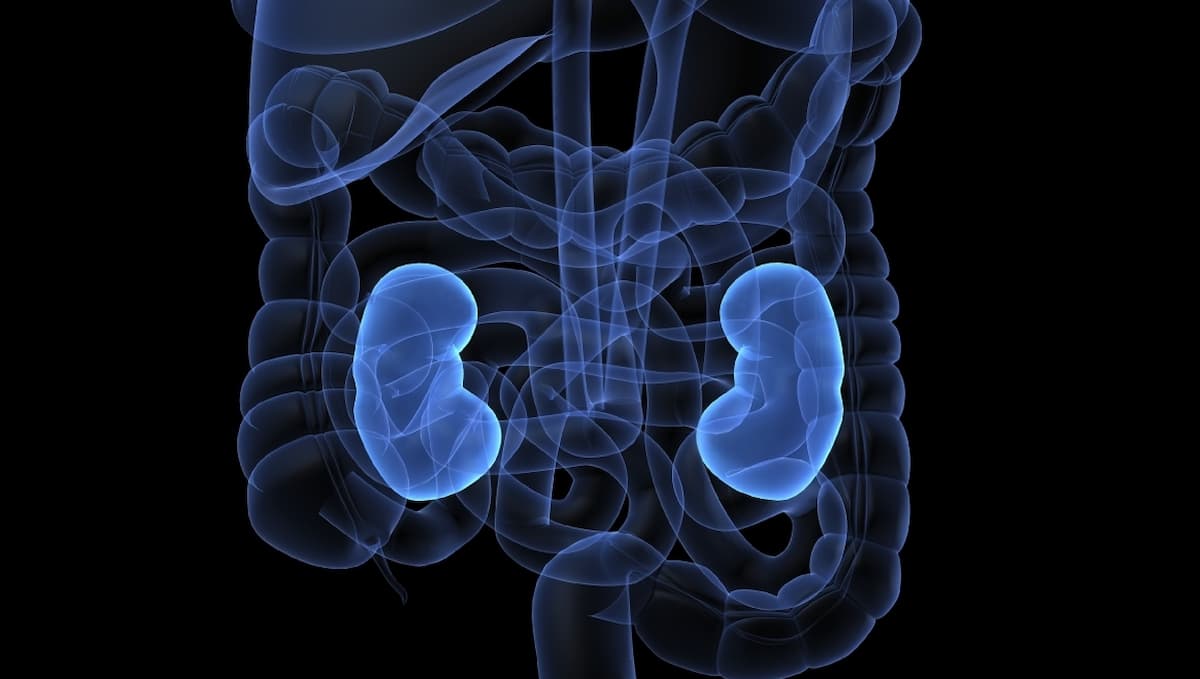Breast tumor trends are similar between women in Ghana and Black women in the U.S., suggest findings published October 13 in JAMA Network Open.
Researchers led by Brittny Davis Lynn, PhD, from the National Cancer Institute in Rockville, MD,…

Breast tumor trends are similar between women in Ghana and Black women in the U.S., suggest findings published October 13 in JAMA Network Open.
Researchers led by Brittny Davis Lynn, PhD, from the National Cancer Institute in Rockville, MD,…

Combining fruquintinib (Fruzaqla) with sintilimab (Tyvyt) significantly improved progression-free survival (PFS) vs axitinib (Inlyta) or everolimus (Afinitor) monotherapy among patients with locally advanced or metastatic renal cell carcinoma (RCC), according to a press release on findings from the
With a median follow-up of 16.6 months and a cutoff date of February 17, 2025, data from the phase 3 portion of the trial revealed a median PFS of 22.2 months in the fruquintinib arm and 6.9 months in the comparator arm (stratified HR, 0.373; P <.0001). Additionally, the objective response rate (ORR) was 60.5% vs 24.3% (OR, 4.622; P <.0001), with a median duration of response (DOR) of 23.7 months and 11.3 months in each arm.
Data related to overall survival (OS) were still maturing at the time of analysis. Investigators noted efficacy benefits with the fruquintinib combination across all prognostic risk subgroups based on the International mRCC Database Consortium (IMDC) guidelines.
Treatment with fruquintinib plus sintilimab appeared to be tolerable and comparable with prior reports of each agent. Grade 3 or higher treatment-emergent adverse effects (TEAEs) occurred in 71.4% of the experimental arm and 58.8% of the comparator arm.
Investigators will present detailed results from the FRUSICA-2 trial at the
“The FRUSICA-2 trial results provide compelling evidence that fruquintinib and sintilimab may offer a valuable new treatment option for patients with advanced [RCC],” co-leading principal trial investigator Dingwei Ye, MD, PhD, a professor at Fudan University Shanghai Cancer Center, stated in the press release.1 “These findings show the combination’s potential to address a critical unmet need for this patient population, delivering consistent benefits across varied patient profiles and prognostic risk groups.”
According to the press release, China’s National Medical Products Administration is currently reviewing a new drug application for fruquintinib plus sintilimab as a treatment for those with previously treated metastatic or locally advanced RCC based on data from the FRUSCIA-2 trial.
Investigators of the open-label, active-controlled, registration FRUSICA-2 trial assessed the safety and efficacy of fruquintinib plus sintilimab vs monotherapy with axitinib or everolimus among 234 patients with second-line advanced RCC. In the combination arm, patients received fruquintinib at 5 mg orally each day in a 2-week-on, 1-week-off schedule every 3 weeks per cycle plus sintilimab at 200 mg intravenously every 3 weeks.2
The trial’s primary end points included PFS in part 1 and ORR in part 2. Secondary end points included the disease control rate, DOR, time to response, OS, safety, and quality of life.
Patients 18 to 75 years old with histologically or cytologically confirmed RCC, locally advanced or metastatic disease, and progression on or after prior frontline treatment with a VEGF-directed tyrosine kinase inhibitor were eligible for enrollment on the trial. Other eligibility criteria included having at least 1 measurable lesion per RECIST v1.1 guidelines, an ECOG performance status of 0 or 1, and adequate organ function.
Those with prior receipt of approved systemic anti-cancer therapy within 2 weeks of beginning study treatment, active autoimmune or inflammatory diseases, or known central nervous system metastases were ineligible to enroll on the trial. Patients were also unsuitable for study entry if they had a history of pneumonitis requiring corticosteroid therapy, a history of or current interstitial lung disease, or current active pulmonary infection.
“The FRUSICA-2 study suggests that fruquintinib and sintilimab could play a meaningful role in shaping second-line treatment strategies for advanced [RCC],” co-leading principal investigator Zhisong He, a professor at Peking University First Hospital, said in the press release.1 “These results point to the combination’s potential to enhance clinical outcomes, providing a new option for managing this challenging disease.”

When it comes to saving Earth from a potential doomsday rock, knowing where to hit it and how it spins could make all the difference. Two new studies presented last month at the Europlanet Science Congress in Helsinki may have just given…

Reality TV star Pete Wicks said he would die a happy man if he could spend the rest of his life caring for dogs, as he confirmed his dog documentary was back for another season.
Wicks rose to fame when he appeared on The Only Way Is Essex in 2015,…

A secondary analysis of a randomized clinical trial of 200 US elementary-school classrooms concludes that portable high-efficiency particulate air (HEPA) purifiers were linked with a modest reduction in respiratory virus diversity but not less viral exposure.
For the study, published late last week in JAMA Network Open, a Boston Children’s Hospital–led research team examined data from the School Inner-City Asthma Intervention Study, which was conducted from September 2015 to June 2020 in 39 public schools in the Northeast. The goal was to determine whether HEPA filtration reduced asthma symptoms.
The researchers randomly assigned classrooms in a 1:1 ratio to receive either four active HEPA purifiers (109 classrooms) or four identical filterless sham HEPA units (91). The team collected week-long bioaerosol samples three times during the school year and measured levels of 19 respiratory viruses using digital droplet polymerase chain reaction (ddPCR).
The primary outcome was high viral exposure (clustering of individual virus concentrations), and secondary outcomes were viral diversity (number of virus types) and individual virus levels. The median class size was 19 students, and the median grade was 3. Only 23.5% of classrooms had central heating, ventilation, and air-conditioning systems.
While HEPA purifiers are effective at reducing fine and coarse particulate matter, their effectiveness against viral aerosols and droplets in clinical settings is unclear, because it depends on factors such as occupancy, ventilation, indoor climate, and occupant-specific characteristics such as age, the researchers said.
“In addition, while low-cost sensors exist for some indoor pollutants, none exists for detection of viruses,” they wrote. “Some studies propose using carbon dioxide (CO2) as a surrogate marker for viral exposure; however, most research on built-environment factors and viral exposures is model-based, lacking comprehensive epidemiologic evidence.”
Viruses were detected in 98.5% of 532 bioaerosol samples (median, 3 viruses per classroom). The most common virus was rhinovirus (89.5% of samples), followed by respiratory syncytial virus (RSV) B (23.9%) and RSV A (12.4%), and influenza A and B (17.7% and 14.3%, respectively).
Air purifiers did not reduce overall viral load in classrooms, suggesting that additional interventions may be needed in schools.
A total of 22.2% of air samples had higher average concentrations of most viruses, including coronavirus and influenza A. The use of HEPA purifiers wasn’t tied to lower odds of high viral exposure (odds ratio [OR], 0.50) but was associated with a 32.8% decrease in viral diversity. But reduced viral diversity wasn’t linked to fewer school absences.
Environmental risk factors for viral exposure were low relative humidity, lower grade in school, winter season, and higher levels of coarse particulate matter.
“We found that air samples from classrooms included in our study had an average of three different respiratory viruses per classroom, with some having as many as 13, including pathogens capable of causing serious disease such as respiratory syncytial virus (RSV) and influenza virus,” corresponding author Peggy Lai, MD, MPH, of Massachusetts General Hospital, said in a Brigham and Women’s Hospital news release.
“Air purifiers did not reduce overall viral load in classrooms, suggesting that additional interventions may be needed in schools,” she added.
Lai highlighted the association between lower humidity and high viral exposure, which suggests that controlling humidity may help lower exposure to certain viruses.
“In addition to air filtration or better ventilation, maintaining classroom humidity between 40% and 60% may help lower viral exposures and improve comfort for students and teachers,” she said. “While our study did not find that HEPA air purifiers reduced high viral exposure in classrooms, it’s important to note that the trial was originally designed to measure other outcomes.”
The authors called for more research into multicomponent environmental interventions such as those targeting higher relative humidity to lower respiratory virus exposure in schools.
This request seems a bit unusual, so we need to confirm that you’re human. Please press and hold the button until it turns completely green. Thank you for your cooperation!

IDH mutations, which are a major target of interest in acute myeloid leukemia (AML), are also present in a minority of patients with myelodysplastic syndrome (MDS). Due to the durability of response and favorable tolerability of IDH1 inhibitors, targeting these mutations in MDS has been investigated and has shown promise favorable survival outcomes a phase 1/2 study (NCT02719574) with a cohort of 22 patients receiving olutasidenib (Rezlidhia).
These patients were treated in a range of settings with olutasidenib including in combination with azacitidine or as a single agent, and in the front line or after disease relapse, resulting in an overall response rate (ORR) of 59% and a median overall survival (OS) of 27.2 months, demonstrating the potential use of a targeted therapy in MDS.1
“If you have an IDH1 mutation, that is just so important to know in MDS and should drive therapy decisions,” said Justin Watts, MD, associate professor in the hematology division at the University of Miami Miller School of Medicine.
In an interview with Targeted Oncology, Watts discussed the outcomes in this trial of patients with MDS and how to approach using an IDH1 inhibitor. In the upcoming second part of this interview, Watts discussed the significance of the long-term durability of response with olutasidenib that has been observed in some patients with AML and the next steps in research for IDH-targeted agents in AML and MDS.
Targeted Oncology: Could you describe the background for the use of olutasidenib in MDS?
Justin Watts, MD: Olutasidenib was first developed for patients with relapsed/refractory AML with an IDH1 mutation, and its approval was in that population. We had wanted to look at MDS the whole time. In the phase 2 portion of the study, we developed multiple subcohorts for other populations, including patients with MDS. What we did which I really liked was that we were quite broad, allowing both frontline and relapsed/refractory MDS or HMA [hypomethylating agent] progression, and both single-agent or combination therapy with azacitidine, which had not yet been done in MDS with an IDH1 inhibitor. That was a very good move by us at the time, because MDS is a rare disease, and this is a rare mutation. It allowed us to accrue enough patients early to get a sense of what was happening.
What were your findings in the phase 1/2 study of patients with MDS?
First, I would say that this was a very high-risk MDS population. There were no low-risk patients, and there were only a couple of intermediate-risk patients. Eighty-six percent of the 22 patients were high or very high risk, and some even had AML by new criteria like the International Consensus Classification. That being said, what we have seen in AML is that the patients who do very well tend to have lower blast counts and fewer mutations and lack of signaling pathway mutations—more resembling MDS, just their blasts are over 20%. So we weren’t surprised to see that these patients with MDS overall did very well with a 60% ORR in a mixed population, which…is greater than expected with standard-of-care azacitidine, or HMA alone, using a targeted therapy in both a single-agent and combination setting.1
The OS was equally impressive, and I think that’s due to both duration of response in the responders and the achievement of transfusion independence even in patients who don’t have a full complete response [CR] or an optimal response, which is also very important for long-term outcomes. There was notable achievement of transfusion independence, or maintenance of transfusion independence if they were independent at baseline on the study, a real lack of myelosuppression, and the [median] OS was around 27 months for the entire population.… But even when you looked at the relapsed/refractory [patients], who historically have OS on the order of 5 or 6 months, it was over 16 months in this group. So that was very encouraging.
How does the approach to treating patients with MDS differ from treating those with AML?
If you have an IDH1 mutation, that is just so important to know in MDS and should drive therapy decisions. There aren’t many targetable mutations in MDS like we see in AML. In fact, IDH1 and IDH2 are really the only 2 that cross over between both MDS and AML—being a little more common in AML than MDS, about twice as common for each one. You don’t see that with NPM1, FLT3, and other kinase mutations that may be targetable, so I think that’s notable.
It’s one of our only targeted therapy options in MDS, so arguably, an IDH1 inhibitor could be incorporated into any frontline approach with or without HMA in MDS. Even in lower-risk patients, we sometimes see them with IDH [mutations]. Some other studies have looked there, and their blood counts get better. IDH-mutated patients are going to respond better to an IDH1 inhibitor if it’s the real driver. In AML, when there’s 9 other mutations or when there’s FLT3…and the IDH is subclonal, not dominant, it’s probably not going to get you what you want, at least not as a single agent.
[In] MDS or low-blast AML, this is not always the case, but usually those are the patients who do better. Those are the patients who I think most benefit from these inhibitors. They can have that long duration of response to either single-agent IDH1 inhibition, or with the addition of HMAs, must also benefit patients with AML. As we know with the frontline ivosidenib [Tibsovo]/azacitidine data, it’s really a synergistic combination, especially if they have other significant driver mutations that need combination therapy.
How do you decide if patients should get an IDH1 inhibitor in the frontline vs relapsed MDS setting?
We’re dealing with a rare mutation in a relatively rare disease. It’s impossible to have randomized controlled trials when it’s in 3% to 5% of patients with MDS. You have to use the data you have at hand, and you have to use your judgment. When you combine the totality of the MDS data [for] ivosidenib, enasidenib [Idhifa]—which is IDH2, but basically the same pathway—and olutasidenib, all 3 of the trials had maybe 20 to 30 patients on them.1-3 You’re not going to get more than that. And when you look at those collective data, and you look at the ivosidenib/azacitidine data in patients with AML who are older, many who have secondary AML [and receive] the other IDH1 inhibitor, [and see] how good those data are in the frontline setting, why would it not be just as good in the frontline setting in a patient with high-risk MDS? [If] they have 15% blasts vs 25%, [does] that dictate their outcome?
When you have a well-tolerated targeted agent in a patient with higher-risk MDS—and with the failure of venetoclax [Venclexta] in MDS—that IDH [inhibitor] plus azacitidine [or] azacitidine/HMA combinations in the frontline make a lot of sense. They may or may not be on the guidelines. That’s shifting. It’s not approved for that, but ivosidenib is now approved for MDS, and I believe olutasidenib may be in that process.
For a low-risk patient you have other options, and a single agent may be more appropriate. For relapsed/refractory patients [with] active [disease], it depends on what prior therapy they’ve had…their age, how frail they are…. But there are some cases of relapsed/refractory [disease] where you may salvage the response to progression on HMA but continuing the HMA still provides some benefit if they’re not heavily pretreated, and adding the IDH [inhibitor] gets them over the hump. We’ve seen that scenario as well in patients on these clinical trials who basically all had prior HMA, were refractory with that, and they still responded.
I think guidelines try to reflect this. They reflect of that these agents are available, and they may not be category 1 [because] there were not randomized phase 2 trials, but we have to use what we have for these patients, especially when the drugs have such a favorable adverse event profile.
Could you describe the tolerability of IDH1 inhibitors?
Differentiation syndrome can happen even in MDS. It’s less common; it’s usually less severe. Each trial had it [roughly] once. But it is something still to know, especially in a patient with more proliferative MDS. That is the one thing I would keep in mind, and there is that potential risk to monitor for early on. That’s the most clinically significant [adverse event]. The other ones are well tolerated in terms of most AML/MDS drugs and chemotherapy, and they don’t cause excess myelosuppression. There are some drug-drug interactions and QT interval monitoring with [ivosidenib] and some hepatotoxicity, usually manageable with adjustments and so on with [olutasidenib], but those are uncommon and rarely grade 3 or severe enough to make you have to stop therapy. Sometimes the dose needs to be adjusted down, but even that’s rare.
References:
1. Cortes JE, Yang J, Roboz GJ, et al. Olutasidenib alone or combined with azacitidine in patients with mutant IDH1 myelodysplastic syndrome. Blood Adv. Published online July 16, 2025. doi:10.1182/bloodadvances.2025016718
2. DiNardo CD, Roboz GJ, Watts JM, et al. Final phase 1 substudy results of ivosidenib for patients with mutant IDH1 relapsed/refractory myelodysplastic syndrome. Blood Adv. 2024;8(15):4209-4220. doi:10.1182/bloodadvances.2023012302
3. Sebert M, Chevret S, Dimicoli-Salazar S, et al. Enasidenib (ENA) monotherapy in patients with IDH2 mutated myelodysplastic syndrome (MDS), the Ideal phase 2 study by the GFM and Emsco Groups. Blood. 2024;144(suppl 1):1839. doi:10.1182/blood-2024-201317

Hello Sunshine hosted its third annual Shine Away summit over the weekend, bringing 2,000 women to the Universal Studios lot for two days of conversations spanning Hollywood, books, finances, health and lifestyle, with Reese Witherspoon at the…

It’s the spooky season but, honestly the scares and horrors of IT are year round. However, our community can help you prepare for the worst kind of haunting: workplace disasters. Inspired by the tactical life lessons from Zombieland,…